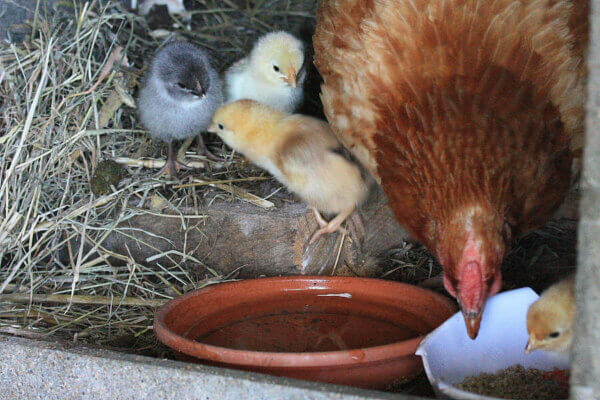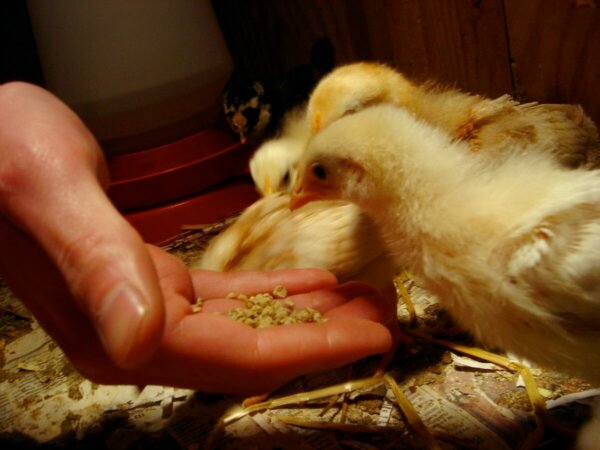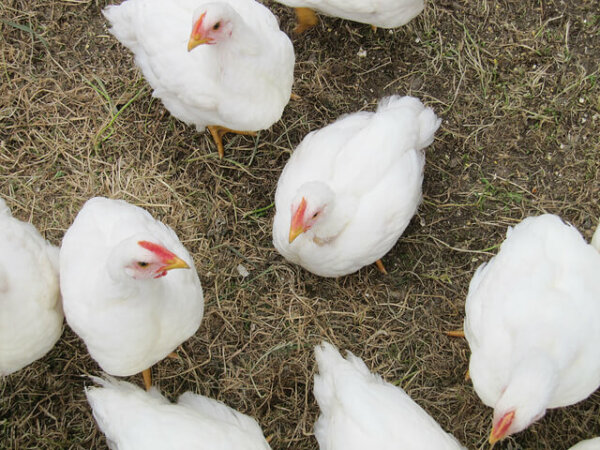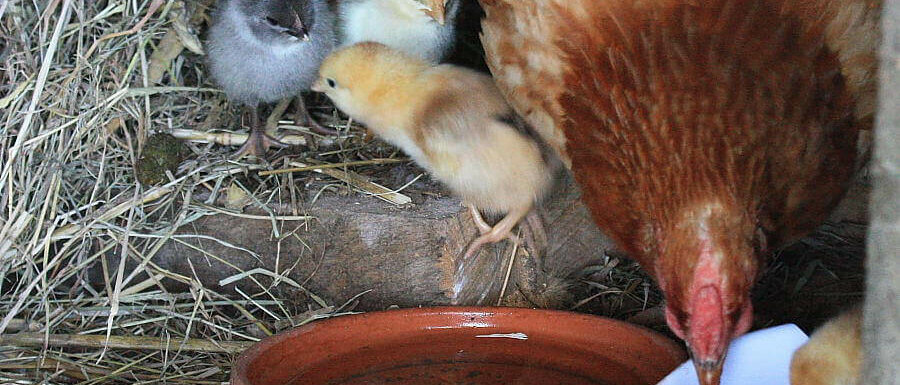Mixing your own feed ration, rather than buying prepared feed, is one of the best ways to save money if you raise chickens (or any animal). You can also be certain about the quality and origin of what your animals are eating.
However, to make sure your birds stay healthy, you have to mix the correct balance of nutrients for their age. If the balance is wrong they will grow slowly, stop laying, or even get sick. A flock of chickens will eat your kitchen scraps, but they cannot survive off of them. Making your own feed is a big responsibility that requires prior knowledge. Let’s look at some of the things you need to know before you start feeding your animals yourself.
Making your own feed is a big responsibility that requires prior knowledge. Let’s look at some of the things you need to know before you start feeding your animals yourself.
Chickens are omnivores – they eat the same varieties of food that humans do. That means that like humans, they cannot live healthily on lettuce and watermelon rinds, nor do they get nutrients from grass like ruminants can. A well-balanced chicken feed needs to be made up of balanced parts protein and carbohydrates and added micronutrients – vitamins and minerals.
Protein
Proteins are the building blocks of life. Without sufficient protein, animals will grow slowly, act lethargic, and have reduced immune defenses. The good news is that all whole grains have some protein content, and with a little knowledge and mathematics it is easy to measure the protein content of feed.

Protein is measured in terms of a percentage. That is the percent of the dry weight of the food that is protein. For example, soybean meal, the most common protein source in US animal feed, is 51% protein.
Carbohydrates
Carbohydrates give your animals all the energy they need. Cereal crops like corn, wheat, barley, and oats are classic. Other less common options include triticale, buckwheat, and rice. Rye can be used as a feed but only in small quantities as it contains toxins that make other nutrients difficult for animals to absorb.
Conventional animal feeds often contain just one source of carbs and one source of protein, usually corn and soy. This is an effective feed mix. However, in my experience, animals thrive with more variation in their diets. If you have the ability, try mixing two carbohydrates, like wheat and oats, or oats and corn. Again, you can test the protein content in your grains to get a more accurate protein ratio in your feed.
https://www.instagram.com/p/BT0P9lygQCk
If you are buying whole grains, your chickens will benefit from it being ground up for better digestibility. Adult hens can grind whole grain in their crops as long as they have access to grit, but chicks definitely need ground grain. If you can buy cracked corn, rolled oats, split peas, soybean meal, or cracked wheat and barley, you can bypass the need for grinding.
Micronutrients
All kinds of animals need small amounts of various organic and inorganic substances that are not necessarily present at high levels in their food. Even chickens with lots of room to forage for bugs need supplemental micronutrients. Most farm and garden stores sell mineral mixes designed to be added into feed to supply necessary nutrients and salts to an animal’s diet.
Every type of animal needs a different mix of minerals, and they are not interchangeable. For example, pigs and poultry need higher levels of copper, which can actually poison sheep or goats. Chickens need different mineral concentrations at different ages also.
https://www.instagram.com/p/BRVj3P3F9yj
The easiest way to get the proper mix of nutrients is to buy a pre-mix. They can seem expensive, but you need very small quantities so a pricey bag can last a long time. Follow the directions on the bag for ounces of minerals to pounds of feed.
You can also approximate a chicken nutrient mix using kelp meal, which is high in vitamins, minerals, salts, and oyster shells as a source of calcium. If you decide to go this route, watch for fatigue, reduced laying, reduced appetite, and other symptoms of nutrient imbalance.
Laying Hens
The most important mineral for laying hens is calcium. Sufficient calcium is the most important factor to ensure strong, healthy egg shells and prevent health problems like osteoporosis. However, to be properly absorbed into a chicken’s body, other nutrients including phosphorus and vitamin D need to be in balance and the calcium needs to be in a chemical form that is bioavailable.
The best source of calcium for laying hens is ground oyster shells, which are easily available to a chicken’s body once they are ground in the gizzard. They are also relatively cheap to buy in 50-pound sacks. You can leave a tray of oyster shells in your chicken run for your layer hens to free-feed.
Young Chicks
Young chicks do not need as much calcium as laying hens. Up until about 15 weeks, chicks need no supplemental calcium, other than what is already in their mineral mix, and too much can actually cause kidney damage. If you are buying pre-mixes, look for a “chick mix.”

While it is not technically a nutrient, chickens also need indigestible grit in their diet – literally small pieces of gravel. These get stored in their crop and help grind up grains and leafy greens. In my experience, chickens that are free range in the dirt will find enough grit themselves, but if they are contained in a small area, indoors, or if you have particularly fine soil, you can buy chicken grit and allow chickens to free-feed.
The Formula For Chicken Food
Each flock of chickens requires a different mix of food. Here’s how to figure out what your birds need.
- A laying hen needs 15-18 percent protein in their feed. If the protein ingredient is, for example, wheat at 12 percent protein, then out of 100 pounds of feed, 12 pounds of it will be protein.
- If you wanted to make the feed 18 percent protein, you’d need to add six pounds of protein to it.
- But no (natural) meal is 100% protein. You need to figure out how much to add, based on the protein content of your additive. Let’s say you were using soybean meal. Soybean meal is 51% protein, so divide the number of pounds of protein you need by .51.
- 6 lbs./.51 = 11.75 lb. soybean meal. This is the amount of soybean meal you need to add. But now you have more than 100 pounds of feed—your protein ratio isn’t exactly 18 percent.
This is why protein requirements are always given in ranges—there is room to fudge a little. Always aim high. A little extra protein is unlikely to hurt a chicken.
If this math seems challenging or non-intuitive, check out the Pearson’s Square model for calculating feed ratios. It works best with two feed ingredients but can be used with multiple steps for more complex mixes.
All whole grains and cereals contain some protein, and beans and legumes are particularly good sources. Animal products like whey, fish waste, and mealworms are also a great source of protein if you can come by them cheaply. To correctly formulate a feed, you need to know what percent protein your ingredients contain. For an excellent starting place, try Feedipedia, a great online resource for learning more about feed ingredients.
https://www.instagram.com/p/BVyTt9Cg_2L
Every grain and legume crop has variation in protein depending on the nitrogen content of the soil. Nitrogen is the key element in protein chains, so grain crops that have been more heavily fertilized will contain more protein. You can test the protein content of your feed at an agricultural laboratory. Contact your local extension service to find out where in your region you could order those tests.
Young chicks need more protein in their feed than adult animals. For efficient growth and the best results, feed your younger birds separately from your adult flock.
Troubleshooting Feed
Symptoms of nutrient imbalance or lack of protein can be subtle and easily confused with symptoms of other diseases. Check out our article here on chicken diseases. The first symptoms you will see are likely to be lethargy, weight loss, and reduced egg production, potentially followed by diarrhea, and feather loss in extreme cases. Unfortunately, those symptoms also occur in just about any kind of chicken illness.
Elimination of the potential cause is the best test to distinguish between illness and malnutrition. If you start noticing worrying behavior in your flock, especially if it is in all the birds, buy some professionally mixed feed from the farm and garden store, and feed it for a few weeks. If symptoms don’t improve within ten days, your feed is not the culprit. However, if you do see an improvement, it’s time to look closely at your mineral and protein sources, and maybe get your feed mix tested for nutrient levels.

As a side note, hens can be very aggressive toward one another, especially toward a new, younger, or otherwise “outsider” chicken in their midst. A chicken at the bottom of the pecking order can suffer malnutrition, even starvation if the other hens bully her away from the food.
In this case, feed the bird separately and then try to upset the social dynamic by moving the coop, introducing another “underdog” chicken, or separating the flock into several smaller groups.
Getting started mixing your own feed can seem overwhelming with all of the details to track and math involved! It may take some trial and error to find the right grains, proteins, and nutrient mix.
However, once you find a mixture that works for you and your flock, it is a cost effective alternative to store-bought feed, and you will quickly learn the basics to become a more educated chicken owner.
As always, your chickens will be the best indication of your success. Watch their behavior, and as long as they are healthy and happy, all is well.










































Leave a Reply